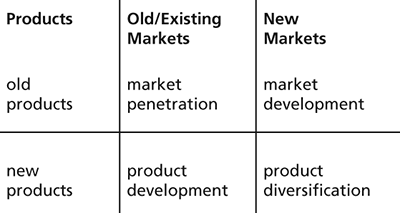product–market strategy
product–market strategy(Ansoff matrix) A marketing planning model. Companies can sell either existing or new products; and they can sell them either in markets familiar to them (existing markets) or in new markets. The resulting two-by-two matrix gives four alternative strategies for increasing sales. One is to concentrate on selling more existing products into existing markets (market penetration), by such means as price reductions and increased advertising. This is regarded as a low-risk low-gain strategy offering few prospects of sustained growth in the longer term. Alternatively, an organization can modify or improve its existing products and sell these to current customers (product development); for example, a lawn-mower manufacturer might install a more powerful motor in its products. The third option is to sell existing products to a new market (market development)—for example, to export the current range of lawn mowers to America. These two strategies are medium-risk with good prospects for growth in the medium term. The highest-risk strategy is to develop new products for new markets (product diversification)—for example, for the lawn-mower manufacturer to develop printing machinery for the publishing industry. Despite the higher risk, this is considered the best strategy for long-term growth. See alsodefender strategy; prospector strategy.

Product–market strategy.
- field experiments
- field sales manager
- FIFO cost
- file
- file server
- file transfer protocol
- fillér
- fils
- final dividend
- final invoice
- final salary scheme
- finance
- finance bill
- finance company
- finance house
- finance vehicle
- financial accounting
- Financial Accounting Standards Board
- Financial Action Task Force on Money Laundering
- financial adviser
- financial appraisal
- Financial Conduct Authority
- financial control
- financial crisis
- financial distress